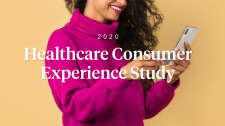Study Finds 40% Uptick in Consumers Who Have Switched or Stopped Going to a Healthcare Provider Because of a Poor Digital Experience

NEW YORK, December 7, 2020 (Newswire.com) - Cedar, an innovative patient engagement and financial technology platform, today announced the results of its annual Healthcare Consumer Experience Study, finding that against the backdrop of the COVID-19 pandemic, digital impressions matter more than ever before—28% of consumers have switched or stopped going to a healthcare provider because of a poor digital experience, a 40% increase from 2019. The latest results, conducted by Forrester Consulting from over 1,500 responses, identify trends in the patient financial experience, including the impact of COVID-19.
Conducted during the pandemic, the study demonstrates the acceleration of necessary changes in digital health. When it comes to billing, even more patients are using digital tools: text message use alone has grown by over 200% in the past year, while email and patient portal use have grown by 82% and 34%, respectively.
Yet, more than half of consumers (57%) have delayed care due to the pandemic, highlighting the need for improved digital health measures. While 44% of consumers would like a vaccine before engaging with care, they also generally want telemedicine options (44%), digital forms and communication (41%), and touchless check-in (37%) in light of the pandemic.
"The COVID-19 pandemic has not only accelerated the adoption of digital health but has also done us the favor of identifying flaws and areas for improvement with these tools," said Florian Otto, CEO and co-founder of Cedar. "One in 10 consumers simply won't pay their bill if they can't understand it. It's clear that the financial experience is a critical component of the broader patient journey, and as a result, providers can't afford to disregard patient financial engagement now that exceptional, end-to-end digital experiences are the norm."
Despite digital health tools becoming more ubiquitous with care, providers still have a long way to go in meeting consumer expectations and preferences:
- 31% of consumers don't think their healthcare providers have done enough to improve their patient billing and payment processes
- 49% wish their digital healthcare experience was smoother and more intuitive, similar to experiences with Amazon, Netflix or Uber
- 68% say it is important to be able to customize their experience with a healthcare provider
The patient experience has become a critical function of providers' bottom line, and the social network effect in healthcare is pervasive:
- 54% of respondents note that they consult online reviews to choose a healthcare provider, with 98% of them saying that those reviews are influential in some way
- 65% say that they would be very likely to recommend a healthcare provider or write them a good review if they offer a great digital experience
- 53% of consumers would consider switching doctors to get touchless paperwork and virtual care, in light of the COVID-19 pandemic
Although expectations around digital tools are becoming more prevalent, subtle differences between age groups highlight the need for personalized experiences:
- Consumers between ages 23-54 are more than twice as likely to prefer interactions through a patient portal, compared to those 74 and older
- Almost one-quarter (23%) of consumers between ages 18-54 wish they were able to use more consumer-friendly payment solutions, like Apple Pay or Venmo, when paying medical bills, compared to only 6% of those 55 and older
- Consumers between the ages of 18-54 are at least 4x as likely to consider switching doctors if they didn't provide more digital experiences than those over age 55, such as touchless check-in and virtual care
In addition to highlighting patient preferences for digital health experiences, survey results also suggest mounting concerns over rising healthcare costs and paying medical bills. Ninety percent of respondents express worry about rising healthcare costs over the next five years, and 84% are worried about paying their healthcare costs in the next year. Additionally, 54% have had a medical bill go to collections, with reasons including being unable to pay (24%), poor or outdated billing and notification processes (22%), believing they were billed incorrectly (17%) and finding the bill too confusing (11%).
"Exceptional end-to-end patient experiences are now the norm, and that's no exception for the financial journey," said Arel Lidow, President and co-founder of Cedar. "The future is touchless and contactless, and by investing in the right patient engagement technology, providers can deliver on the financial experience patients crave, meet rising expectations around digital health tools and address concerns around healthcare costs with more transparency."
For the study's complete results, download the report here. To learn how Cedar's patient financial engagement platform can help improve the end-to-end patient journey, visit: www.cedar.com.
About Cedar
Cedar is a healthcare financial engagement platform for hospitals, health systems and medical groups that clarifies and simplifies the financial experience for patients, improving bill resolution and payment outcomes for providers. Recently named one of the most innovative healthcare tech companies of 2020 by a survey of 300 healthcare executives in the KLAS Emerging HCIT Companies report, Cedar facilitates patient-centric financial engagement across the care journey using intuitive and advanced data science. To learn more, visit www.cedar.com.
Contact
Jenny Fiegoli
Content & Communications Director
E: jenny@cedar.com
C: 847.975.7888
Source: Cedar
